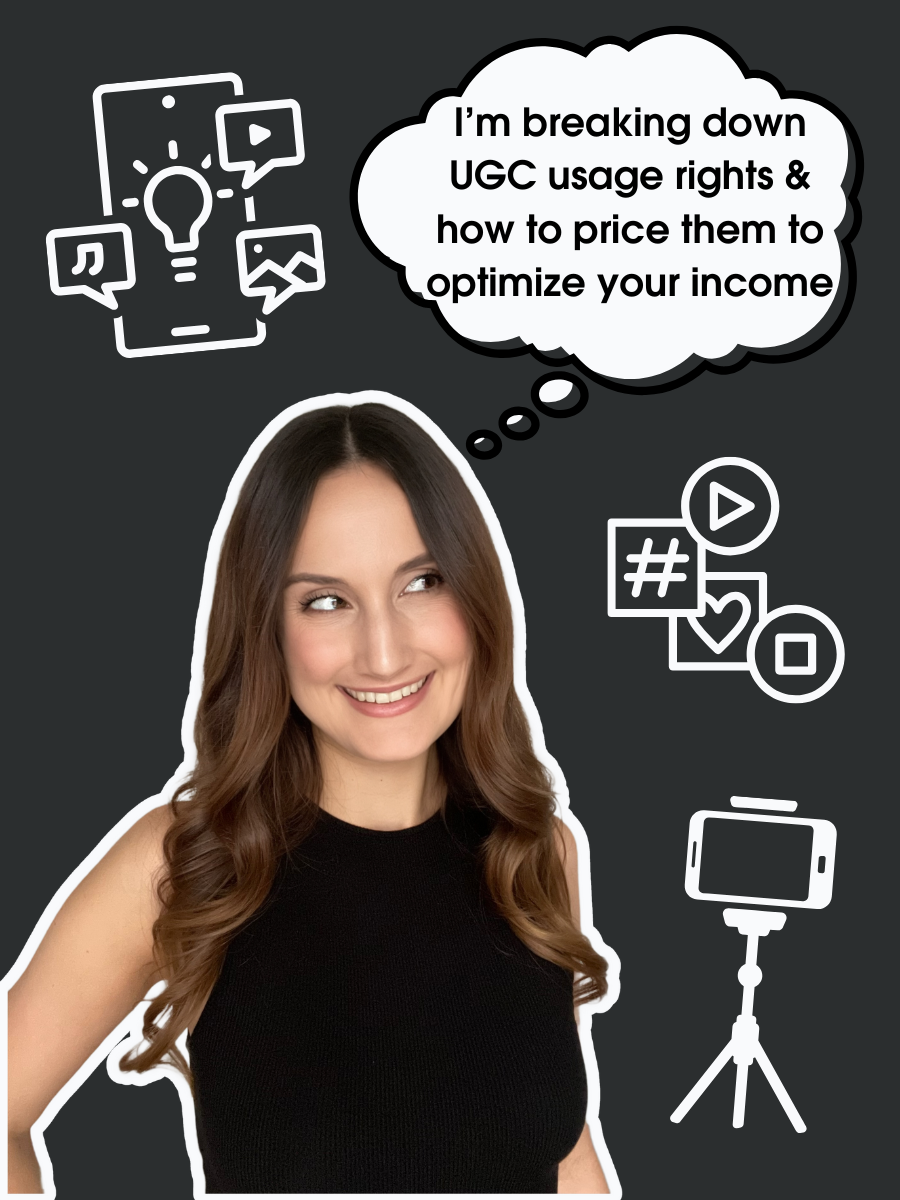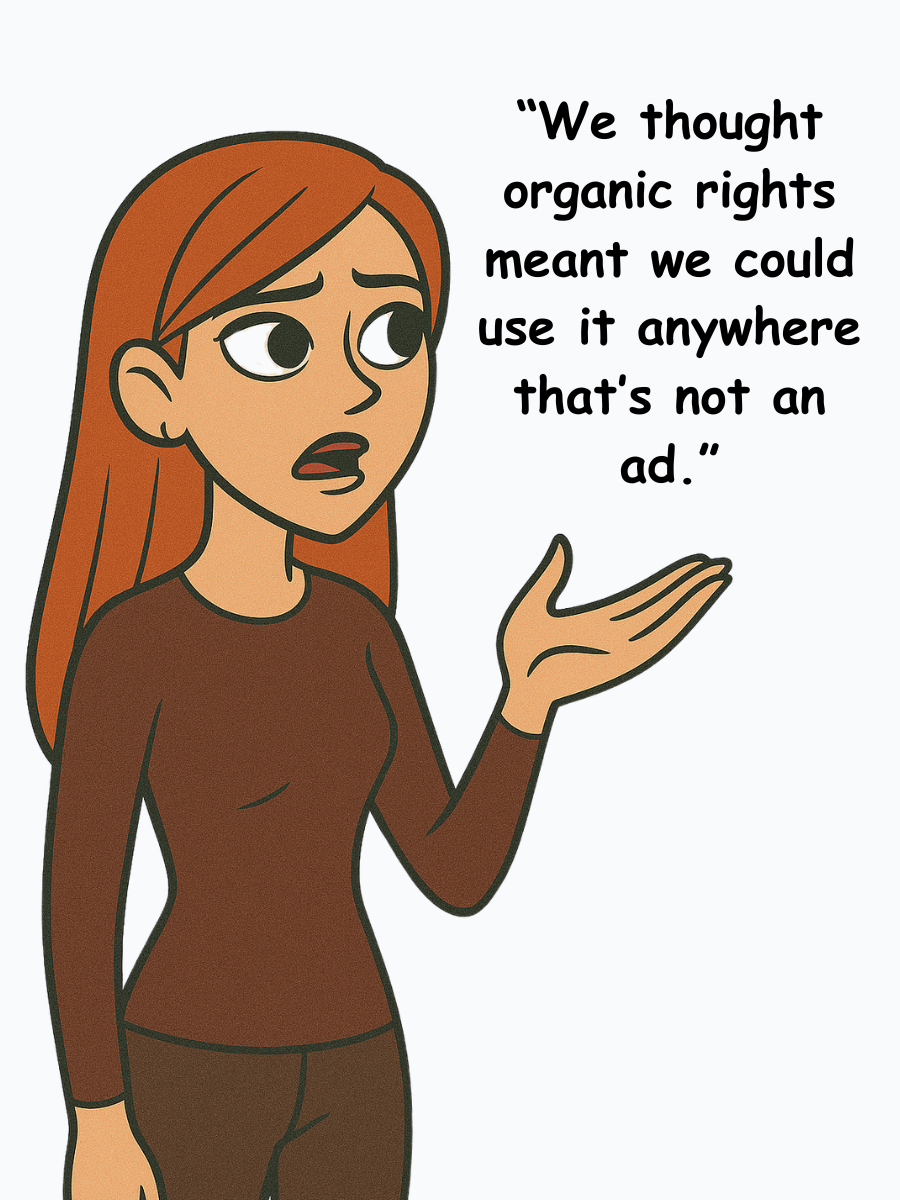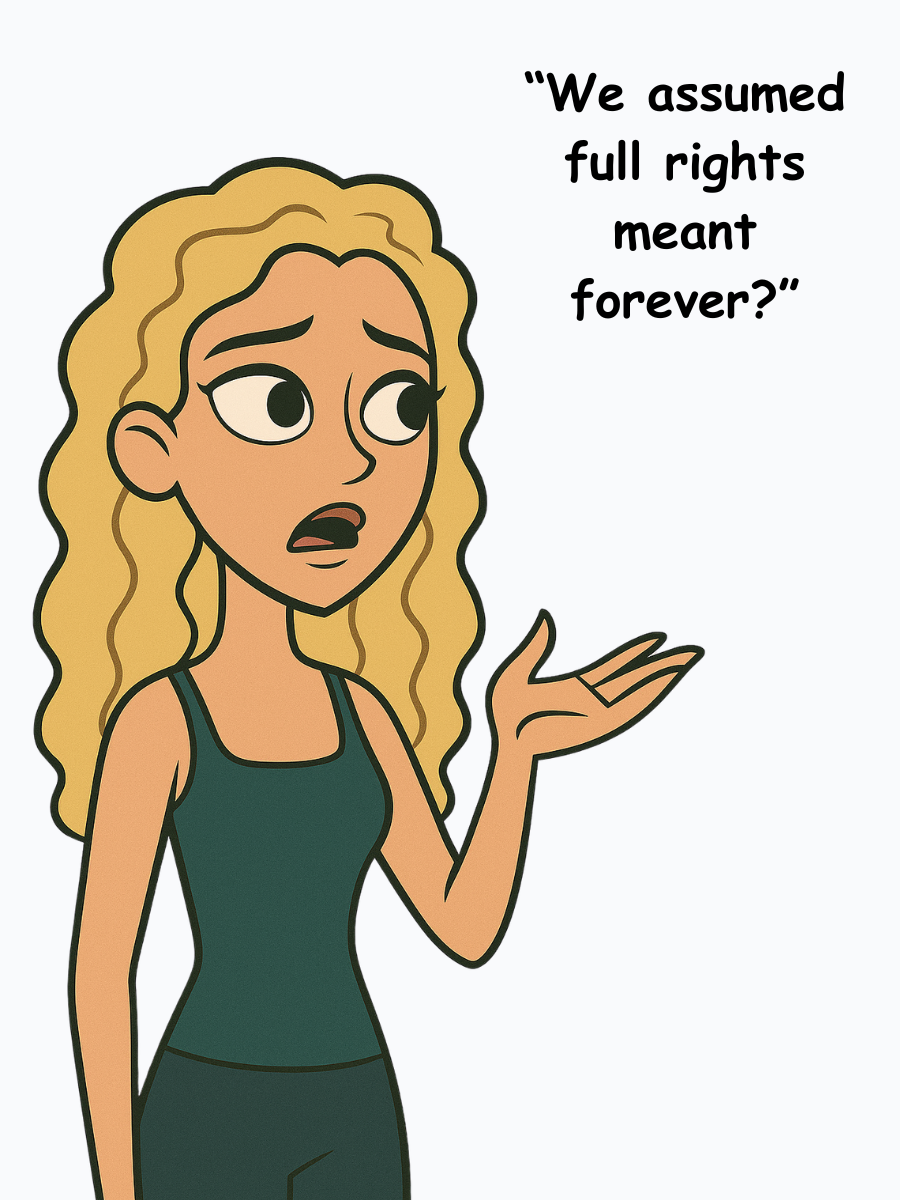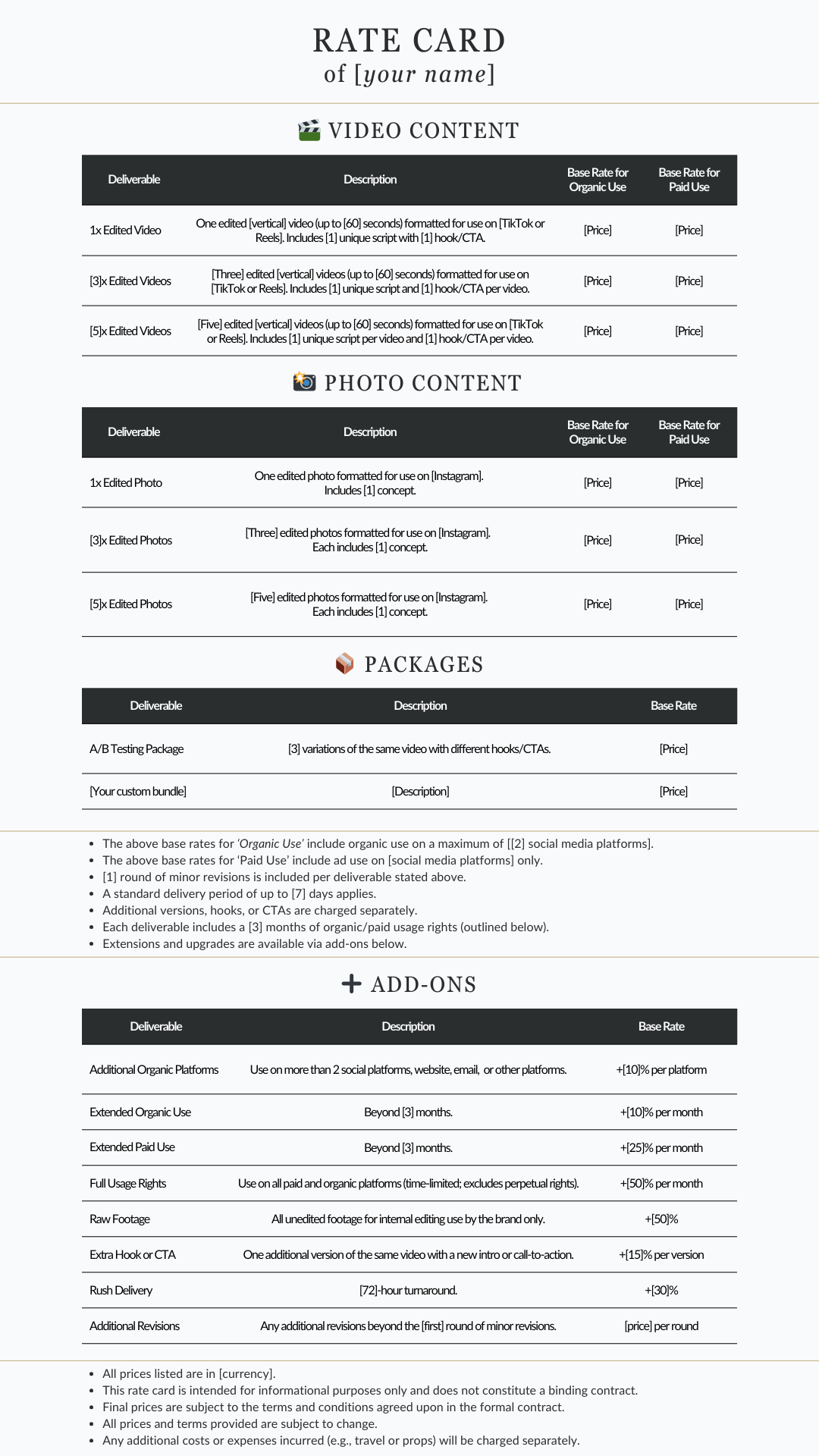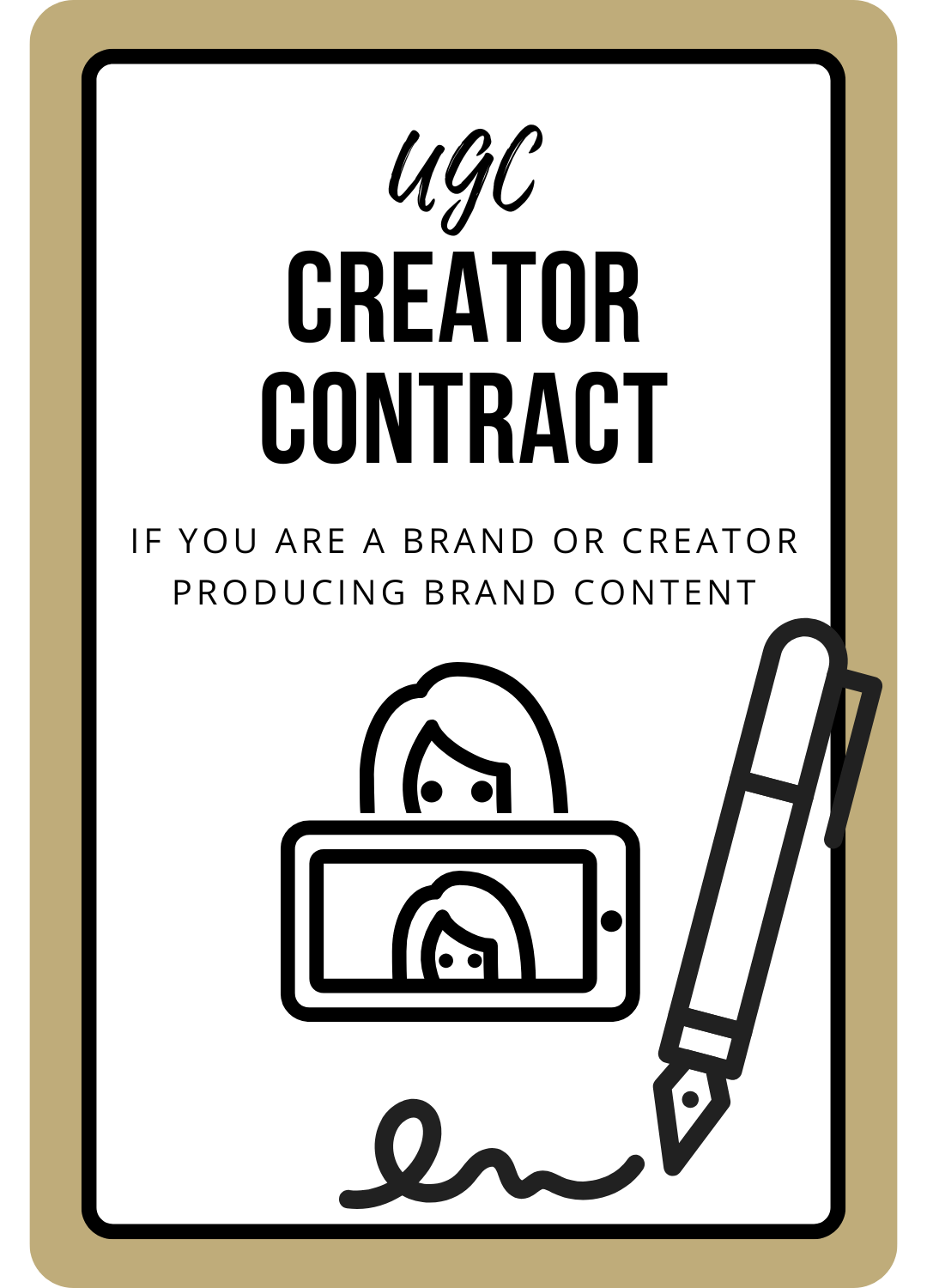UGC Usage Rights 101: What to Charge for Organic vs. Paid vs. Full Use (+ Free UGC Rate Card Template)
What are UGC usage rights, and how do you charge for them? I’m breaking down everything from organic to paid to full to usage rights in perpetuity and how to price them to optimize your income.
UGC usage rights define how, where, and for how long a brand can use your content — and they’re one of the most important (and overlooked) parts of your pricing.
As a lawyer for creators and the creator of a best-selling UGC contract template, I’ve helped UGC creators protect their work, price smarter, and stop giving away valuable UGC usage rights for free. I’ve also created a customizable UGC rate card template that’s legally aligned with how UGC usage rights should actually work.
In this blog post, you’ll learn all about:
The difference between organic usage rights, paid usage rights, full usage rights, and usage rights in perpetuity
The UGC usage rights rates you should charge
What usage rights to include in your base fee
How to charge for add-ons
How usage rights fit into your UGC rate card & UGC usage rights contract
So you can protect your content and earn more from every deal.
You’ll walk away knowing exactly how to explain and price your UGC usage rights, how to structure them inside your rate card, and how to use your contract to keep it all enforceable without needing to rewrite it every time you change your rates.
This post is all about UGC usage rights and how to charge for them to optimize your UGC income.
UGC Usage Rights Explained
Usage Rights Meaning: Organic vs Paid vs Full vs Usage Rights in Perpetuity Explained
Before you can charge the right UGC usage rights rates, you need to understand what the brand is actually paying for — and that starts with usage rights.
Usage rights define how the brand is allowed to use your content: where they can post it, whether they can run ads with it, and how long they can use it for. If you’re not clear about this in your UGC rate card and UGC usage rights contract, the brand might assume they can do whatever they want — and that’s exactly how you lose money on content you worked hard to create.
Here are the 4 main types of UGC usage rights you must understand and define:
1. Organic Usage Rights
Organic usage rights meaning:
The brand can post your content organically, meaning, on their own social media accounts. However, that does not include boosting it or using it for ads on social media.
Organic usage rights typically include non-paid posting on SM platforms like:
Instagram (Feed, Stories, Reels)
TikTok
Facebook (Feed, Reels)
YouTube Shorts
Pinterest
LinkedIn (for B2B creators)
Organic usage does not include:
Paid ads (Meta, TikTok, Google, etc.)
Website use (product pages, landing pages, etc.)
Email marketing (newsletters, automations)
Internal use (pitch decks, investor materials)
Any third-party publishing or platforms the brand doesn’t own
Important limits to define in your UGC rate card and contract:
Platform scope: You should limit organic use to 1–2 platforms in your base rate (e.g., Instagram + TikTok). If they want to post it on YouTube Shorts or Pinterest, too? That’s an add-on.
Timeframe: Organic usage should be time-limited. I recommend including 3 months in your base rate, but some include up to 6 months. If the brand wants to post it for longer, they pay a monthly extension fee.
Why it matters:
If you don’t limit the platforms or duration for UGC usage rights, the brand could post your video everywhere… and keep it up forever — all for a one-time fee. Posting your content organically across 5+ platforms — or keeping it up for a year — gives the brand more reach and value. Those IGC usage rights should come at a higher rate.
2. Paid Usage Rights
Usage rights meaning:
The brand uses your content in paid ad campaigns, which means they are putting money behind it to promote their product.
These paid usage rights typically include:
Meta Ads (Facebook & Instagram)
TikTok Spark Ads or In-Feed Ads
YouTube pre-roll or in-stream ads
Pinterest Ads
Google Ads
Boosted posts (even if the post appears organic)
Why it matters:
Paid ads = direct profit for the brand. They’re using your face, voice, and/or work to sell a product at scale — and that’s way more valuable than a single organic post. So, you should charge more for paid usage rights.
What to define:
Platform use — Paid usage usually refers to social ad platforms. If they want to use it in emails or on their website, that’s a separate license.
Duration — You should never offer unlimited paid usage. I recommend charging a separate, higher base rate for paid usage rights and including 3 months of paid use (or less), and then charging for monthly extensions.
What UGC creators often get wrong:
Many beginner UGC creators include paid ad usage in their (normal) base rate without realizing it. They don’t define how the content can be used, and thus give the brand full usage rights. They then see their video running as an ad for 6 months, but they only get paid once. Don’t let that happen to you.
3. Full Usage Rights
What it is:
The brand can use your content across all platforms, in both organic and paid ways, including:
Social media (organic + ads)
Website
Email marketing
Internal decks or presentations
Landing pages
BUT: Full usage rights still need to be time-limited unless you’re selling a full buyout (and charging accordingly). You don’t want to grant usage rights in perpetuity.
How to structure it:
Offer full usage rights as a premium add-on
Charge it on a monthly basis
Why it matters:
Full usage rights are the most flexible and valuable UGC usage rights you can give a brand, so it should come at a premium. It gives them total control over how and where they use your content — but not forever. Creators often mistake full usage rights for usage rights in perpetuity, but it’s not the same!
4. Usage Rights in Perpetuity
What it is:
The brand can use your content forever, with no expiration date and without ever paying you again — in organic posts, ads, emails, website placements, and beyond. That means:
Unlimited platforms
Unlimited time
Unlimited campaigns
Unlimited impressions
Why you should never include this in your base rate:
Once you grant perpetual rights, you’ve lost all licensing leverage. Even if the video performs well, gets millions of views, or the product becomes a bestseller — you won’t see a dollar more.
When it might be acceptable:
For faceless content (e.g., hands-only demos or flat lay product shots)
If the brand is paying a buyout fee (and you’re okay never using the content again)
Even then, perpetual rights should be the exception, not the norm.
Want to go deeper into why perpetual usage rights are risky?
👉 Read my full breakdown on usage rights in perpetuity and why they matter
How to Set UGC Usage Rights Rates (With Clear Examples)
Now that you know what organic, paid, full usage rights, and usage rights in perpetuity actually mean, let’s talk about what really matters:
How do you charge for them?
And more importantly, how do you make sure you’re not giving them away for free?
1. What to Include in Your Base Rate
Your base rate is where most UGC creators accidentally lose money by including more UGC usage rights than they should, without charging for it.
Here’s what I recommend including in your base UGC rate per deliverable:
✅ A standard base rate with 3 months of organic usage rights on a maximum of 2 social media platforms
✅ A separate higher base rate with 3 months of paid usage rights
2. What to Charge for Additional UGC Usage Rights
The easiest way to scale your pricing and keep things flexible is to use percentages instead of fixed rates.
This way, if you change your base rates, you don’t have to manually update every add-on.
Here’s a breakdown of common usage rights add-ons and how you could price them:
Extended organic usage rights — each additional month of organic use beyond the 3 months included in your base rate: +10% per additional month
Extended paid usage rights — each additional month of paid use beyond the 3 months included in your base rate: +25% per additional month
Additional platforms — Use on more than 2 social platforms or other platforms, like email or website: +10% per platform
Full usage rights — use on any platforms without limitation (but not perpetual): +50% per month
3. Pricing Examples
Let’s say your base rate for one edited UGC video is $200, and it includes 3 months of organic use on TikTok + Instagram.
Example 1: The brand wants paid ad use for 3 months
$200 base + (25% × 3 months = $150)
➡️ Total: $350
Example 2: The brand wants to post the video for 6 months and use it on their website
$200 base
(10% × 3 extra months = $60)
(15% × 6 months website = $180)
➡️ Total: $440
Example 3: The brand wants full usage rights across all platforms for 3 months
$200 base + 75% add-on = $350 total
Reminder: These percentages aren’t “industry standard.”
UGC is relatively new, so everyone charges differently. Anyone who claims their rates are standard is really just pulling numbers out of their you-know-what. These numbers are suggestions based on what’s reasonable, scalable, and easy to manage — and you can adjust them depending on your niche, the brand’s size, your demand, and your experience.
As long as you’re charging something for extended or commercial use, you’re already ahead of most creators who are still giving it away for free.
Download My Free UGC Rate Card Template (That Goes Beyond Just Organic and Paid Usage Rights)
If all of this is starting to sound overwhelming, I’ve got you.
I created a free UGC rate card template that takes all the guesswork out of pricing, usage rights, and deliverable descriptions. It’s designed for UGC creators who want to look professional, get treated fairly by brands, and stop giving away extras for free.
Here’s what’s included in the template:
Editable deliverables with clean, professional descriptions
Base rates that define what’s included — and what’s not
Clear boundaries around usage rights (e.g., organic use for 3 months on 2 platforms)
Add-ons priced by percentage so you can scale your rates without starting over
No fluff — no “About Me” section, no unnecessary content type lists
Guidance throughout to help you fill it out with confidence
Whether you’re just getting started or you’re ready to level up your UGC usage rights rates, this template will help you create a UGC rate card that actually protects your work — and gets you paid fairly.
What Your UGC Usage Rights Contract Must Include to Protect Your Content
Your UGC rate card tells the brand what you charge for UGC usage rights.
But your UGC contract is what makes those rates — and the usage rights tied to them — legally enforceable and protects you from major liability risks.
Yes, a simple agreement over email can be legally binding…
But it won’t protect you when things go wrong.
Without a proper UGC contract in place, here’s what could happen:
❌ The brand edits, re-cuts, or reuses your content in a future campaign without your permission — because your rate card didn’t say how they can (or can’t) modify it
❌ The brand delays or withholds payment — because you never spelled out payment deadlines or how additional months for UGC usage rights are billed.
❌ The brand asks for “just one more version” or “a quick edit” — because you didn’t define how many hooks, CTAs, or revision rounds are included.
❌ The brand wants a refund because your video didn’t “perform” — even though performance isn’t your responsibility.
❌ You get dragged into a copyright or consumer complaint because the brand used your content in the wrong way — or gave you incorrect claims to include.
These are real risks. And they happen all the time when UGC creators rely only on email threads or rate cards.
That’s why you need an ironclad UGC contract!
With my UGC Creator Contract Template, you’ll have a lawyer-drafted agreement that:
✅ Defines what UGC usage rights are included and for how long
✅ Covers revisions, deliverables, payment terms, and boundaries
✅ Includes liability disclaimers and copyright protections
✅ Pairs seamlessly with your rate card — no need to rewrite anything when you update your pricing
You can even attach your rate card as Schedule A or an exhibit. That means:
You don’t have to renegotiate or re-sign every time you change your rates
You can update your rate card anytime, send it over, and stay legally protected
You stay flexible and in control, like a true professional
Your contract lays the legal foundation.
Your rate card outlines the deal.
Together, they protect your income, your content, and your creative freedom.
👉 Ready to protect your UGC deals like a pro?
Grab my customizable UGC Creator Contract Template and finally create UGC deals that pay you what you’re worth (and keep that money with a layer of legal protection).
This post was all about the different types of UGC usage rights and how to charge for them to increase your UGC revenue.
Want to learn more about all the rates you need in your UGC rate card beyond just the UGC usage rights rates? Read these blog posts next:
The Ultimate Uwon’tte Card Guide: What to Include, Pricing Tips + Free Template
